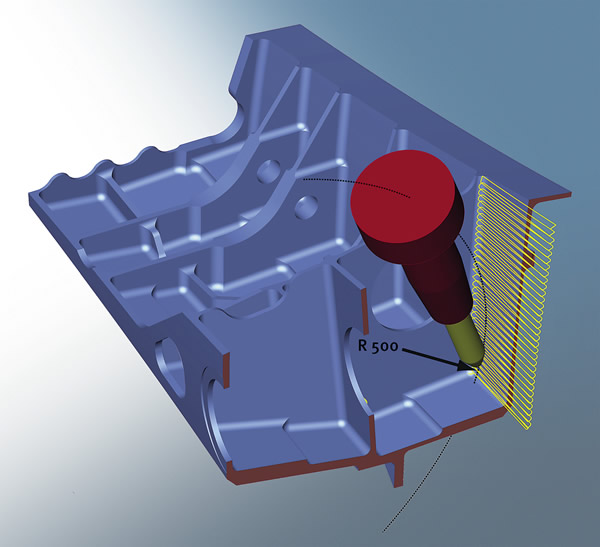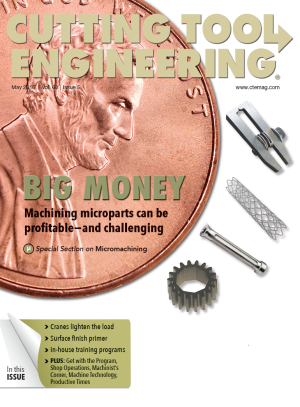Barrel cutters are applied for specialized milling applications, and recent advancements in CAM software expand the use of these tools.
Geometrically, a barrel cutter has a large cutting radius on its side that closely matches the curvature of a part’s surface and allows a large step-over between passes. The result is cycle-time reductions of up to 90 percent when finishing while imparting fine surface finishes.


A segment of a structural part is cut with a conical barrel cutter using hyperMILL’s tangent-plane-machining strategy. The conical barrel cutter's 500mm (19.68") radius is significantly larger than an equivalent ball endmill, as defined by the cutter shank size.

Open Mind Technologies AG in Germany has developed new programming strategies with its MAXX Machining performance package, which utilizes novel geometry adaptations to barrel cutters. The CAD/CAM software developer innovated the conical barrel cutter, and the tool is now a catalog item from Emuge Corp., West Boylston, Mass. In addition, the tool can be readily ground to order by other toolmakers.
The conical barrel cutter follows the general design of a barrel cutter, with a small arc segment of a large radius on its profile. However, the adaptation positions the arc segment at an angle to the axis of the cutter. This opens the conical barrel cutter to a broader set of applications while delivering the same beneficial results.
The conical barrel cutter also has a radius ground into its bottom. This allows the same cutter to be used for blending, creating fillets and detailing organic shapes.
The application set includes machining large automotive molds and dies, which can have a planar surface to facilitate mold locks and clearance surfaces. The tool can also be used to produce large aerospace structural components with pockets that are too deep for traditional swarf milling.
The combination of the new CAM programming strategies and special barrel cutters provides technical benefits. The cone angle on a barrel cutter allows the cutter axis, toolholder and machine spindle to be tilted away from the part surface. Accordingly, applying short barrel cutters can lower cutter costs, enable faster machining parameters and impart finer surface finishes compared to longer ballnose endmills. With proper collision detection and avoidance in the CAM software, the holder, and even the spindle, can confidently enter deep part pockets.
Note that not all CAM software has robust-enough mathematics to ensure that the placement of a cutter does not collide with the workpiece surface. Without high confidence in the CAM calculation, the user may revert to trial and error to define cutter locations in relation to a workpiece.
Open Mind’s hyperMILL machining strategies—tangent plane machining for planar surfaces and tangent machining for ruled or gently arched surfaces—further improve barrel cutters. Surface selections are simple; approach and retract macros effectively control the large radius in corners; additional passes can be taken with the ball end on the bottom of the cutter to clean up and blend fillets and adjoining surfaces; and obstacles can be identified and easily avoided.
The strategies are suitable for 5-axis, simultaneous motion and 3+2 automatic indexing. Some large machines do not readily allow simultaneous motion because of their need to move large machine masses. Automatic indexing, however, produces acceptable surfaces with imperceptible blends.
Because of the large step-overs taken by the barrel cutters, the total toolpath length for a surface is far less than with ballnose endmills. This enables a barrel cutter to produce more parts. For example, a ball endmill cutting a steel block will experience more wear than the barrel cutter, and the potential for a mismatch between different machined regions is greater, especially because more tool wear will dictate more tool changes.
A less obvious application for a barrel cutter is machining the bottom surface of a large pocket, including undercut areas. The conical barrel cutter has a 60° or 70° angle at which the barrel radius is ground into the side of the cutter. The step-over can be five to 10 times larger than that of a ball endmill.
Barrel cutters can play tricks with experienced users who see large step-over witness marks and expect the same rough surface finish that a ball endmill imparts. Test cuts, however, allow tactile feedback, and profilometer readings confirm the surface-finish benefits of a large cutting radius. These benefits will augment the capabilities of CAM software and lead to more applications for conical barrel cutters.
Contact Details
Related Glossary Terms
- clearance
clearance
Space provided behind a tool’s land or relief to prevent rubbing and subsequent premature deterioration of the tool. See land; relief.
- computer-aided manufacturing ( CAM)
computer-aided manufacturing ( CAM)
Use of computers to control machining and manufacturing processes.
- endmill
endmill
Milling cutter held by its shank that cuts on its periphery and, if so configured, on its free end. Takes a variety of shapes (single- and double-end, roughing, ballnose and cup-end) and sizes (stub, medium, long and extra-long). Also comes with differing numbers of flutes.
- gang cutting ( milling)
gang cutting ( milling)
Machining with several cutters mounted on a single arbor, generally for simultaneous cutting.
- milling
milling
Machining operation in which metal or other material is removed by applying power to a rotating cutter. In vertical milling, the cutting tool is mounted vertically on the spindle. In horizontal milling, the cutting tool is mounted horizontally, either directly on the spindle or on an arbor. Horizontal milling is further broken down into conventional milling, where the cutter rotates opposite the direction of feed, or “up” into the workpiece; and climb milling, where the cutter rotates in the direction of feed, or “down” into the workpiece. Milling operations include plane or surface milling, endmilling, facemilling, angle milling, form milling and profiling.
- shank
shank
Main body of a tool; the portion of a drill or similar end-held tool that fits into a collet, chuck or similar mounting device.
- step-over
step-over
Distance between the passes of the toolpath; the path spacing. The distance the tool will move horizontally when making the next pass. Too great of a step-over will cause difficulty machining because there will be too much pressure on the tool as it is trying to cut with too much of its surface area.
- swarf
swarf
Metal fines and grinding wheel particles generated during grinding.
- toolholder
toolholder
Secures a cutting tool during a machining operation. Basic types include block, cartridge, chuck, collet, fixed, modular, quick-change and rotating.
- toolpath( cutter path)
toolpath( cutter path)
2-D or 3-D path generated by program code or a CAM system and followed by tool when machining a part.
- undercut
undercut
In numerical-control applications, a cut shorter than the programmed cut resulting after a command change in direction. Also a condition in generated gear teeth when any part of the fillet curve lies inside of a line drawn tangent to the working profile at its point of juncture with the fillet. Undercut may be deliberately introduced to facilitate finishing operations, as in preshaving.



